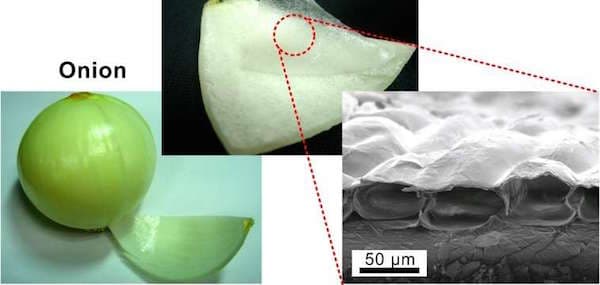Onion Cells Move Out Of Kitchen To Help Build Artificial Muscles
A team of researchers from National Taiwan University have been able to put the good old tear-inducing 'onion' to a a completely new use outside the culinary world. In that they have made use of onion cells to develop artificial muscles that can expand or contract. Now an 'artificial muscle' is a generic term used for set of devices that can bend in different directions due to an external stimulus such as pressure, voltage, current or even temperature. Having wide range of applications in the fields of robotics and pharmaceuticals, artificial muscles are capable of becoming the next highly disruptive technology, thanks to their property of having high power-to-weight ratio and super flexibility.
During their research work, the scientists found that onion's cell structure and dimensions are similar to the microstructure in artificial muscles that they were developing to increase the actuation deformation. The delicate skin just below the onion's surface (also known as its epidermis) is made up of blocky cells arranged in a tightly packed lattice. These epidermal cells are nominated to create a more versatile muscle that could expand or contract while bending at the same time.

The onion's epidermal cells were treated with acid to remove the hemicellulose and coated both sides of it with gold. These gold electrodes were of different thickness to make their stiffness asymmetrical from top to bottom. Their experiments showed that on passing current flowed through these gold electrodes, the onion cells would bend and stretch similar to a muscle.
To control the artificial muscle's response, the asymmetry in the electrodes came in handy. On applying a high voltage, the cells would contract and flex upwards, whereas on applying a low voltage, the cells would expand and flex downwards.
For demonstration of their device, the National Taiwan University team combined two onion muscles into a pair of tweezers and showed how they could be used to pick up a cotton ball. This is the first time that a single-layer lattice structure has been used in an artificial muscle to generate unique actuation modes.
They are now working on reduction of the voltage required as well as the actuating force. If they are successful, we would see artificial muscles with much more lifting power. What are your thoughts about the new research? Share with us in comments below.
Source: Artificial Muscles Created from Gold-Plated Onion Cells | American Institute of Physics
During their research work, the scientists found that onion's cell structure and dimensions are similar to the microstructure in artificial muscles that they were developing to increase the actuation deformation. The delicate skin just below the onion's surface (also known as its epidermis) is made up of blocky cells arranged in a tightly packed lattice. These epidermal cells are nominated to create a more versatile muscle that could expand or contract while bending at the same time.

The onion's epidermal cells were treated with acid to remove the hemicellulose and coated both sides of it with gold. These gold electrodes were of different thickness to make their stiffness asymmetrical from top to bottom. Their experiments showed that on passing current flowed through these gold electrodes, the onion cells would bend and stretch similar to a muscle.
To control the artificial muscle's response, the asymmetry in the electrodes came in handy. On applying a high voltage, the cells would contract and flex upwards, whereas on applying a low voltage, the cells would expand and flex downwards.
For demonstration of their device, the National Taiwan University team combined two onion muscles into a pair of tweezers and showed how they could be used to pick up a cotton ball. This is the first time that a single-layer lattice structure has been used in an artificial muscle to generate unique actuation modes.
They are now working on reduction of the voltage required as well as the actuating force. If they are successful, we would see artificial muscles with much more lifting power. What are your thoughts about the new research? Share with us in comments below.
Source: Artificial Muscles Created from Gold-Plated Onion Cells | American Institute of Physics
Replies
You are reading an archived discussion.
Related Posts
Most of us love Android but when it comes to users’ privacy, we come to know about its darker side. A team of security researchers from France’s Eurecom and Technicolor...
Name: Angel Dy
*Engineering Trade: Civil Engineering
Location: Philippines
*Occupation: 4th year Civil Engineering Student
Work Experience: Worked as a Private Math and English Tutor
*Hobbies & Interests: Engineering, Engineering,...
I am a 4th year civil engineering student. I am not so sure what to do or where to go after my school days. I am planning to take an...
If you are the kind of person who usually forgets things like remote, wireless headphones, flashlights, video game controllers, camera, et al then you must have faced situations when locating...
A phone based app that can do point-of-care blood test is a major step forward in control of many weakening diseases and a need of the hour. Amazingly, a team...
